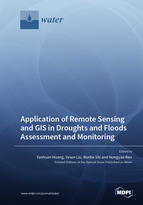Application of Remote Sensing and GIS in Droughts and Floods Assessment and Monitoring
A special issue of Water (ISSN 2073-4441). This special issue belongs to the section "New Sensors, New Technologies and Machine Learning in Water Sciences".
Deadline for manuscript submissions: closed (26 November 2022) | Viewed by 19560
Special Issue Editors
Interests: remote sensing; GIS; water cycle; hydrological model; precipitation extremes; floods; droughts; spatial analysis; land use and land cover change
Special Issues, Collections and Topics in MDPI journals
Interests: remote sensing; GIS; machine learning; waterlogging; flash floods; hydrological model; precipitation extremes; digital twin watershed; knowledge graph
Special Issues, Collections and Topics in MDPI journals
Interests: remote sensing of environment; GIS; quantitative remote sensing; wetland vulnerability; coastal monitoring
Special Issues, Collections and Topics in MDPI journals
Interests: hyperspectral remote sensing; urbanization and water environment; geospatial analysis; water pollution and public health; agriculture and water resources
Special Issues, Collections and Topics in MDPI journals
Special Issue Information
Dear Colleagues,
Driven by global change and population pressure, droughts and floods have been two of the most serious natural hazards that can lead to crop losses and economic havoc in many areas, affecting more people globally than any other natural hazard. As droughts and floods are complex hydrological systems, they deserve a multidisciplinary monitoring effort in order to carry out appropriate and timely hazard assessments. Recently, remote sensing and GIS-based techniques have been widely applied to obtain a synoptic and punctual view over basin-scale monitored areas. It is clear that the application of remote sensing and GIS can potentially provide an extra contribution to drought and flood assessment and monitoring, for instance, in terms of accuracy of results, amount of information obtained, temporal availability, and so on.
We are seeking contributions that integrate the application of remote sensing and GIS techniques, with particular focus on and reference to drought or flood monitoring and hazard assessment. In particular, contributions on various droughts or flood monitoring indexes from UVA and from satellite (e.g., thermal infrared, high time resolution, high-resolution, SAR, GRACE) are welcome and strongly encouraged. The investigative approach characterized by the integration of disciplines at different scales of vision and precision represents a modern challenge to strive for a more complete understanding of drought and flood processes and, therefore, a better hazard evaluation.
Prof. Dr. Yaohuan Huang
Prof. Dr. Yesen Liu
Prof. Dr. Runhe Shi
Prof. Dr. Hongyan Ren
Guest Editors
Manuscript Submission Information
Manuscripts should be submitted online at www.mdpi.com by registering and logging in to this website. Once you are registered, click here to go to the submission form. Manuscripts can be submitted until the deadline. All submissions that pass pre-check are peer-reviewed. Accepted papers will be published continuously in the journal (as soon as accepted) and will be listed together on the special issue website. Research articles, review articles as well as short communications are invited. For planned papers, a title and short abstract (about 100 words) can be sent to the Editorial Office for announcement on this website.
Submitted manuscripts should not have been published previously, nor be under consideration for publication elsewhere (except conference proceedings papers). All manuscripts are thoroughly refereed through a single-blind peer-review process. A guide for authors and other relevant information for submission of manuscripts is available on the Instructions for Authors page. Water is an international peer-reviewed open access semimonthly journal published by MDPI.
Please visit the Instructions for Authors page before submitting a manuscript. The Article Processing Charge (APC) for publication in this open access journal is 2600 CHF (Swiss Francs). Submitted papers should be well formatted and use good English. Authors may use MDPI's English editing service prior to publication or during author revisions.
Keywords
- droughts
- floods
- remote sensing observation
- GIS
- hazard assessment
- monitoring index
- vulnerability
- machine learning
- agriculture
- public health









